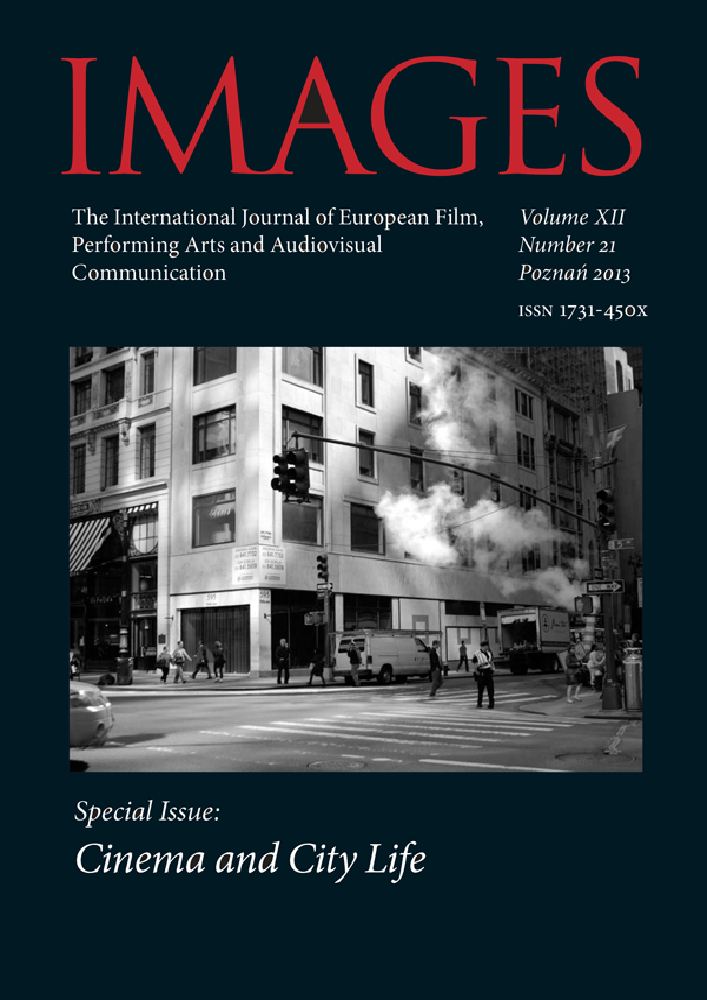Abstrakt
The City in Perpetual Motion. Berlin: Symphony of a Metropolis (1927) by Walter Ruttmann
The atmosphere of a big city, as well as registering the motion of the city as a symbol of modern industrial civilization, fascinated the first directors of photography at the turn of the 20th century. Some years later, the subject of the metropolis was developed by avant-garde artists. Among early cinematic images of the city, the foremost place is held by Walter Ruttmann’s 1927 film Berlin: Symphony of a Metropolis. It was the first multifaceted and comprehensive documentary picture of the city. The city is shown without any anecdote or story, without an individual hero, distinct from theatre or literature. Ruttmann shows the diversity, complexity and co-dependence of the urban organism, which becomes something of a machine in perpetual motion. Ruttmann’s film unveils the uniformity of big-city life, the unification of the imagination, expectations, needs and dreams. The world of “Berlin” is created mainly by editing. Motion – the result of artistic endeavours, together with the rhythmic orderBibliografia
G.Vogt, Die Stadt im Film. Der deutsche Spielfilm 1900–2001, Magdeburg Schüren Verlag, Marburg 2001. Cyt. za: M. Saryusz-Wolska, Berlin: filmowy obraz miasta, Wydawnictwo Rabid, Kraków 2007, s. 51.
P. Rotha, It’s in the Script, „World Film News” 1938 (wrzesień), s. 205. Podaję za: S. Kracauer, Od Caligariego do Hitlera. Z psychologii fllmu niemieckiego, tłum. E. Skrzywanowa i W. Wertenstein, Filmowa Agencja Wydawnicza, Warszawa 1958.
M. Saryusz-Wolska, Berlin: filmowy obraz miasta, op. cit., s. 21, 48.
I. Luba, Berlin. Szalone lata dwudzieste, nocne życie i sztuka, Wydawnictwo Naukowe PWN, Warszawa 2013.
W. Evans, Karl Freund, Candid Cinematographer, „Popular Photography” 1939 (luty), s. 51.
R.W. Kluszczyński, Film – sztuka Wielkiej Awan-gardy, PWN, Warszawa–Łódź 1990, s. 36 i nn.
S. Kracauer, Der heutige Film und sein Publikum, „Frankfurter Zeitung” 1928, 1 grudnia. Cyt. za: idem, Od Caligariego do Hitlera, op. cit., s. 159 i 297). W bardzo zbliżony sposób interpretował film Paul Rotha na łamach „Documentary Film”.
S. Zahorska, Drogi rozwojowe filmu, „Miesięcznik Literacki” 1930, nr 5, s. 242
J. Grierson, Dzieje filmu dokumentalnego, tłum. L. Pijanowski, „Film na Świecie” 1957, nr 5, s. 39–47. Przedruk z: „The Fortingly Review” (Londyn, sierpień 1939).
J. Wittlin, Epopea w kinie, „Wiadomości [17] J. Wittlin, Epopea w kinie, „Wiadomości Literackie” 1928, nr 16.
M. Giżycki, Niech semafory pokażą nową drogę filmom polskim, „Iluzjon” 1984, nr 1, s. 20.
K. Ford, Muzycy a kino, „Ilustrowany Kurier Codzienny” 1931, 21 kwietnia (nr 109); dodatek „Kurier Filmowy” nr 15, s. 16.
Licencja
Autorzy
Autorzy tekstów przyjętych do publikacji w czasopiśmie IMAGES są zobowiązani do wypełnienia, podpisania i odesłania na adres redakcji umowy o udzielenie nieodpłatnej licencji do utworów, z zobowiązaniem do udzielania sublicencji CC.
Zgodnie z umową, autorzy tekstów opublikowanych w czasopiśmie IMAGES udzielają Uniwersytetowi im. Adama Mickiewicza w Poznaniu niewyłącznej i nieodpłatnej licencji oraz zezwalą na użycie sublicencji Creative Commons Uznanie autorstwa 4.0 Międzynarodowe.
Autorzy zachowują prawa do dalszego, swobodnego rozporządzania utworem.
Autorzy, którzy wykorzystują w swoim tekście cudze utwory (np. ilustracje, fotografie) proszeni są o dostarczenie do redakcji czasopisma zgodę na publikację od uprawnionych podmiotów.
Użytkownicy
Zainteresowani użytkownicy internetu uprawnieni są do korzystania z utworów opublikowanych po 2015 roku IMAGES tylko w calach niekomercyjnych, pod następującymi warunkami:
- uznanie autorstwa - obowiązek podania wraz z rozpowszechnionym utworem, informacji, o autorstwie, tytule, źródle (odnośniki do oryginalnego utworu, DOI) oraz samej licencji;
- bez tworzenia utworów zależnych - utwór musi być zachowany w oryginalnej postaci, nie można bez zgody twórcy rozpowszechniać np. tłumaczeń, opracowań.
Do wszystkich tekstów opublikowanych przed 2015 r. prawa autorskie są zastrzeżone.
Inne
Uniwersytet im. Adama Mickiewicza w Poznaniu zachowuje prawo do czasopisma jako całości (układ, forma graficzna, tytuł, projekt okładki, logo itp.).
